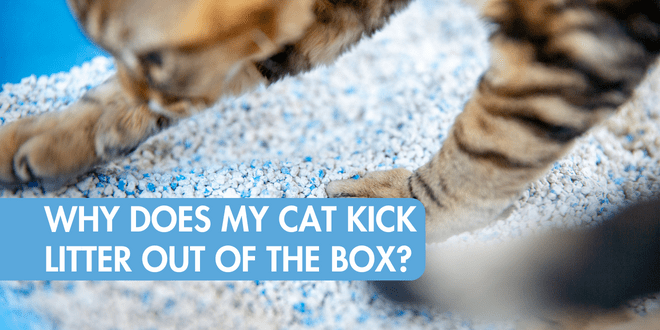
You may live with a cat whose litter box habits are nothing short of spectacular, where not one particle of litter makes its way out of the box. Maybe you’re not so lucky though. Perhaps your cat sends mounds of litter out of the box and onto the floor where you manage to step on it every time you walk by. Your cat may kick so enthusiastically that litter shoots halfway across the room. Why do some cats do that, and is there anything you can do to discourage this behavior?
Why Cats Dig and Cover
For cats in an outdoor environment, staying safe is a priority. The instinct cats have is to find a soft substrate, dig a small hole, eliminate, and then cover their waste. This behavior helps hide their scent so predators aren’t alerted to their presence. The locations cats choose for elimination are also a distance from where they sleep and raise their young. Keeping predators away is a top priority.
Litter Box Restrictions
In the outdoors, cats can stretch their legs out as far as needed to dig to the desired depth. There are also no limitations on how much they cover or how far dirt particles can fly.
In the litter box, however, cats have very definite restrictions regarding how much they can stretch their legs and how deep of a hole can be created. The limitations of the box may cause cats to dig for a longer period of time in an effort to find the perfect spot. Since cats are limited by the walls of the box and the amount of litter, they may also be more exaggerated and awkward in the covering-up motions.
If the box already contains soiled litter, a cat may keep covering because he still detects an odor no matter how hard he tries to conceal it. Additionally, the walls of the typical litter box aren’t very high so if you have a determined cat, you’re bound to have litter up and over the sides. Even covered boxes don’t necessarily reduce litter scatter if the cat has the back end aligned with the opening.
Create More Room in the Litter Box
Since most traditional litter boxes aren’t big enough, I recommend purchasing a large plastic storage container. As a general guideline, the litter box size should be 1 ½ – 2x the length of your cat from tip of the nose to base of the tail. With a storage container you can also choose one with high sides to reduce litter scatter. This way, you don’t have to resort to a covered litter box. To make it easier for your cat to access the high-sided box, cut a low entryway on one end. Be sure to sand sharp edges.
Litter Maintenance
If your cat is a non-stop litter scratcher, make sure it’s not because he isn’t satisfied with the degree of odor control. Scoop the box at least twice a day. If using scoopable litter, thoroughly wash the box once or twice a month. If using non-clumping litter, wash the box weekly or as often as necessary.
If there isn’t enough litter in the box your cat will probably never feel satisfied in his covering attempt for odor control. The scant amount of litter in the box will undoubtedly end up where you don’t want it as kitty tries, in vain, to conceal waste and odor. If you’ve gone overboard with the litter amount you’ll just be inviting your cat to send half of it over the sides of the box. In general, about a 3-inch litter depth is good but customize the amount based on your particular cat’s habits and preferences.
Need More Information?
For more specific information on cat behavior and training, refer to the books by best-selling author Pam Johnson-Bennett. Pam’s books are available at bookstores and online. We’ve also included Amazon links here on our website.
If you have a question about your cat’s behavior or health, contact your veterinarian. This article is not intended as a medical diagnosis nor is it a replacement for your cat’s regular veterinary care. This article is for general information purposes only.

